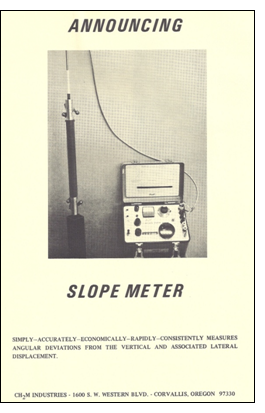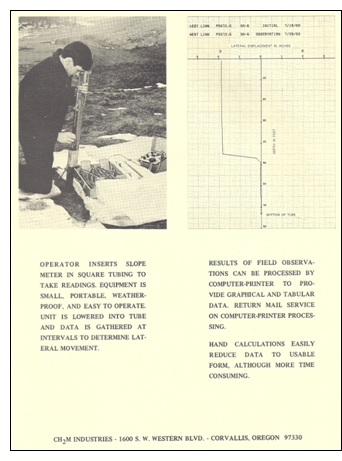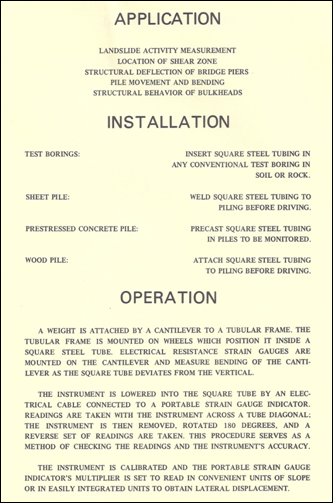as recalled by Larry Well, May 2010
Around the spring of 1967, CH2M was working with the Port of Portland at the Terminal 2 site along St. Helens Road and the Willamette River in north Portland, downstream of the Broadway Bridge. Steel sheet piling was to be driven to provide a dock line that ships could snug up to. As the piling installation work progressed, it was discovered that the sheet wall was failing. The earth appeared to be slipping toward the river under the piling. Could it be an underwater landslide?
The only investigative tool available at that time was the Slope Indicator made by the company of the same name in Seattle. It used expensive, proprietary, and extruded aluminum tubing in sections. The equipment could only be rented and it would be some time before it could be made available.

About this time Harlan Smith, a summer intern, was working with us in the mechanical discipline. Harlan grew up in a machine shop and had a brilliant grasp of mechanisms and problem solving. When he learned of the difficulties at Terminal 2, he offered a solution. He would build a slope meter using the principle of a cantilever beam upon which strain gauges are attached to form a Wheatstone bridge. By measuring the electrical resistance across the Wheatstone bridge, one could determine the amount of deflection of the cantilever. Harlan’s design was simple, fairly easy to build and calibrate, and it used off-the-shelf square structural tubing from any steel yard rather than the expensive extruded aluminum. Harlan built the first slope meter and it was used that summer to locate the depth of the slip-plane in the soil under the piling. The dock was subsequently completed and the slope meter played a part in resolving the problem.
But wait, there’s more to the story. Our geotechnical engineers asked Harlan if he could make a smaller version that we could use to investigate landslides and slope-stability issues. Harlan’s fertile mind went to work and that is where I became involved. I had used a local Corvallis expert machinist, Gus Horvath, to make equipment for our testing laboratory. Harlan showed him his ideas for a miniature version of the slope meter. Gus agreed to make the prototype and we were in business. Based on Harlan’s design, I had the stainless steel “torpedo” bodies and the matchstick-size aluminum cantilever made. I attached the rice grain-size strain gauges to the cantilever to form the Wheatstone bridge. We used a Budd Instruments, Inc. meter to calibrate the instrument and make readings for landslide and slope-stability studies.
Over the next few years Harlan (shown here in the brochure) graduated from OSU and left the firm. The success of the instrument on the port project caught the interest of CH2M Industries and several slope meter systems were made and sold to the Oregon Highway Department, the Federal Highway Administration (two each), the Port of New Orleans, and CH2M HILL.

The slope meter was not patented because the principle of operation was not different enough from the Slope Indicator instrument to warrant fighting the details. The only kind of royalty Harlan and I received was an expensed steak dinner at the Coberg Inn in Eugene from Mike Fisher, then president of CH2M Industries.
About 1975, it was decided to sell the slope meter and its manufacture to Soiltest, Inc. of Chicago. We felt they were in a better position to manufacture and market the instrument than CH2M Industries. Since I had assembled and calibrated most of the slope meters we had made, I also had opportunities to provide training to the new owner’s technical staff around the country.
Specifications
Original Terminal 2 Slope Meter
Meter: Budd, Instruments, Inc.
Sensitivity: One hundredth of an inch
Length: Torpedo, 36 inches
Width: Square cross-section, 2 inches by 2 inches
Guides: Wheels, four each, 1.5 inch diameter, two each, 24 inches apart on opposite diagonal edges
Cable: Waterproof, 5 conductor, 5/16 inch diameter, and 100 feet long marked at 2-foot intervals.
Miniature Slope Meter
Meter: Budd Instruments, Inc.
Sensitivity: One hundredth of an inch
Length: Torpedo, 16 inches
Width: Round, 1-inch diameter
Guides: Wheels, four each, 1 inch diameter, two each, 12 inches apart on opposite sides
Cable: Waterproof, 5 conductor, 5/16 inch diameter, and 100 feet long marked at 2-foot intervals.

